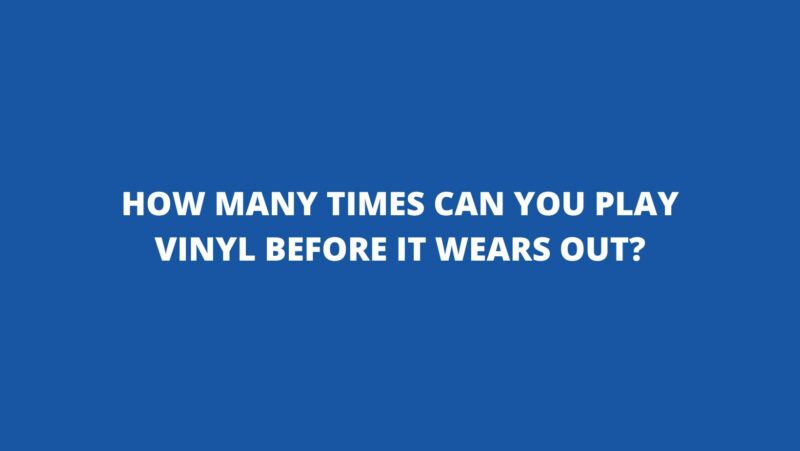Vinyl records, with their analog charm and rich sound, offer a unique listening experience that has stood the test of time. As enthusiasts place the needle on the grooves and immerse themselves in the warmth of analog music, a question often arises: “How many times can you play a vinyl record before it wears out?” The longevity of vinyl records is a topic that sparks curiosity, as the delicate dance between the stylus and the grooves inevitably results in wear. This article explores the intricacies of vinyl record wear through playback, factors that influence this wear, and measures to maximize the lifespan of your cherished collection.
Understanding Vinyl Record Wear
- Mechanical Interaction
Vinyl records consist of grooves etched with audio signals that guide the stylus during playback. As the stylus tracks these grooves, it exerts pressure and friction, resulting in a gradual wearing down of both the stylus and the grooves. This process is an inherent part of vinyl playback and is known as record wear.
- Stylus Wear
The stylus, or needle, is the point of contact between the record and the playback system. As it traverses the grooves, the friction between the stylus and the vinyl causes microscopic abrasions on both surfaces. Over time, the stylus tip can become blunted, leading to changes in sound quality and increased surface noise.
- Groove Deterioration
The grooves of a vinyl record also experience wear during playback. The repeated contact with the stylus gradually wears down the walls of the grooves, altering the original shape and depth. This groove deterioration can lead to reduced audio fidelity and a decline in sound quality.
Factors Influencing Vinyl Record Lifespan
- Stylus Quality and Shape
The quality and shape of the stylus tip play a significant role in determining how many times a vinyl record can be played before wear becomes noticeable. High-quality diamond stylus tips are designed to minimize friction and wear, offering better longevity compared to lower-quality materials.
- Tracking Force
The tracking force, or the pressure exerted by the stylus on the grooves, is a critical factor in record wear. Too much tracking force can accelerate wear, while too little can result in tracking errors. Proper calibration of the tracking force according to manufacturer recommendations helps balance wear and sound quality.
- Record Quality and Thickness
The quality and thickness of the vinyl record itself influence its wear resistance. Higher-quality records and those with thicker vinyl layers are generally more durable and capable of withstanding more plays before wear becomes apparent.
- Playback Equipment and Setup
The quality of playback equipment and proper setup significantly impacts record wear. Well-calibrated turntables with appropriate tracking force and anti-skate adjustments minimize unnecessary stress on the stylus and grooves.
- Dust and Contaminants
Dust, debris, and contaminants that settle on the record surface can exacerbate wear. These particles act as abrasive agents, contributing to faster stylus and groove degradation. Regular cleaning of records and stylus can mitigate the impact of contaminants.
The Lifespan of Vinyl Records
The exact number of plays a vinyl record can endure before wear becomes noticeable varies widely and depends on a combination of factors. Generally, records can withstand anywhere from hundreds to thousands of plays before the wear becomes significant enough to impact sound quality. However, it’s important to note that records do not “wear out” in the sense of becoming unplayable after a certain number of plays. Instead, wear accumulates gradually over time, and the degradation in sound quality is a more noticeable indicator of wear.
Maximizing the Lifespan of Vinyl Records
- Proper Turntable Setup
Proper turntable setup is crucial to minimizing record wear. Accurate tracking force, anti-skate calibration, and stylus alignment help ensure that the stylus follows the grooves accurately, reducing unnecessary friction and pressure.
- Regular Cleaning
Regularly cleaning both records and stylus prevents the buildup of dust and contaminants that accelerate wear. Cleaning solutions, brushes, and anti-static tools can help maintain the integrity of the vinyl surface and stylus tip.
- Rotating Your Collection
Rotating your collection and distributing playtime across multiple records helps prevent excessive wear on specific grooves. This approach ensures that wear is more evenly distributed, prolonging the lifespan of individual records.
- Use High-Quality Stylus and Cartridge
Investing in a high-quality stylus and cartridge combination is essential for reducing wear and maximizing sound quality. Quality components exert less pressure on the grooves and provide a more accurate playback experience.
- Digitization
Consider digitizing your vinyl collection to reduce wear on the physical records. This allows you to preserve the audio quality while enjoying the convenience of digital playback.
Conclusion
Vinyl records are built to withstand numerous plays before wear becomes noticeable enough to impact sound quality. The lifespan of a vinyl record is influenced by various factors, including stylus quality, tracking force, record thickness, and playback equipment setup. While it’s impossible to provide a specific number of plays that a vinyl record can endure, responsible handling, proper care, and optimal playback practices can significantly extend the lifespan of your cherished collection. Embrace the tactile magic of vinyl playback while nurturing the longevity of your records, ensuring that the dance of echoes between the stylus and the grooves continues to enchant for years to come.


